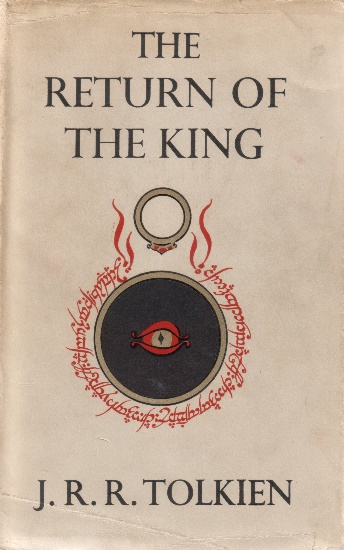 Hobbits. Gandalf. The Ring of Power. Long before the Game of Thrones series, there was the Lord of the Rings trilogy, written by J. R. R. Tolkien. It was a sequel to The Hobbit, which had won critical acclaim upon publication in 1937. By 1954, two volumes of the fantasy series had been published, and fans anticipated the final one, which took its time coming. The Return of the King hit the shelves on October 20, 1955.
Hobbits. Gandalf. The Ring of Power. Long before the Game of Thrones series, there was the Lord of the Rings trilogy, written by J. R. R. Tolkien. It was a sequel to The Hobbit, which had won critical acclaim upon publication in 1937. By 1954, two volumes of the fantasy series had been published, and fans anticipated the final one, which took its time coming. The Return of the King hit the shelves on October 20, 1955.Tolkien had conceived of the trilogy as a single volume. It was to consist of six sections, or books, and to include appendices explaining in detail some earlier events in the history of Middle Earth – the world of Hobbits and Orcs, among other creatures. It was to be more than 1200 pages.
Luckily, his publisher put a stop to that. The tome was divided into three volumes, and the last two books were published as the final volume, with the appendices. Neither did the author get his way on the title. He wanted it to be The War of the Ring because he thought The Return of the King was too much of a spoiler. Maybe he was right, but fans were probably prepared for the king’s triumph anyway, after their nearly year-long wait.
The poet W. H. Auden became a fan. In his New York Times review of the book, he compared the trilogy favorably to no less than Milton’s 1667 epic poem, Paradise Lost. In fact, Auden considered Tolkien’s work superior for its depiction of good and evil: “Mr. Tolkien is not as great a writer as Milton, but in this matter he has succeeded where Milton failed.”
Auden particularly admired the fact that the Fellowship’s quest was to destroy the Ring of Power. This is decided by the coalition of Elves, Men and Dwarves on the “good” side, all of whom successfully reject the temptation to keep the Ring for themselves. As Auden wrote: “Evil, that is, has every advantage but one – it is inferior in imagination. Good can imagine the possibility of becoming evil – hence the refusal of Gandalf and Aragorn to use the Ring – but Evil, defiantly chosen, can no longer imagine anything but itself. Sauron cannot imagine any motives except lust for domination and fear so that, when he has learned that his enemies have the Ring, the thought that they might try to destroy it never enters his head, and his eye is kept toward Gondor and away from Mordor and the Mount of Doom.”
More than 5,000 reviewers on Goodreads seem to agree with that review. To date, The Return of the King has 4.49 out of 5 stars on the site from more than 400,000 readers. Many may have read the Del Rey edition of the book featured on the site. Possibly they read it after watching Peter Jackson’s film adaptations beginning in 2001. On the book’s cover is Viggo Mortensen, the titular king from the films.
The coincidence
Mortensen was born on October 20, 1958 – exactly three years after the publication of The Return of the King.
One of three sons in a Danish-American family, Mortensen was born in New York City. They lived in Venezuela, Denmark and Argentina, so he can speak and write in Spanish as well as Danish. He returned to New York with his mother after his parents divorced, and then moved around again after earning a degree in Spanish studies and politics. He lived in Spain and England, and drove trucks and sold flowers in Denmark.
True to his varied nature, Mortensen is not only an actor but also a poet, musician, photographer and painter. He has published multimedia books of poetry, music and art. With much of his earnings from the Lord of the Rings films, he established Perceval Press, an independent publishing house. He sang his own coronation song as Aragorn at the end of the third film, when the king returns to Gondor.
Mortensen made his film debut in the 1985 thriller Witness. He played an Amish man who feels threatened when Rachel (Kelly McGillis), the woman he hopes to marry, becomes too close with Detective John Book (Harrison Ford). Other early films include Carlito’s Way (1993), Crimson Tide (1995), G.I. Jane (1997) and A Perfect Murder (1997). He was cast as Aragorn in 2001 to replace original cast member Stuart Townsend, just before the filming of the whole trilogy began in New Zealand. Having been a character actor for most of his career, Mortensen might even have declined the role. Luckily, his son Henry is another Tolkien fan and gave him some good advice. Besides, considering the coincidence, he was destined for the role! The trilogy was a massive hit. The Return of the King was nominated for 11 Oscars, and it swept them all, tying it with Ben Hur and Titanic for the most Academy Awards earned by a single film.
That made Mortensen a leading man. Among other projects from then on, he teamed up with director David Cronenberg three times and won critical acclaim for starring roles in A History of Violence (2005), Eastern Promises (2007) and A Dangerous Method (2011). He was nominated for a Best Actor Academy Award for playing a Russian gangster in Eastern Promises. On the list were George Clooney, Johnny Depp, Tommy Lee Jones, and Daniel Day-Lewis, who won for There Will Be Blood.
Mortensen’s most recent film to date is Far from Men, adapted from a short story by Albert Camus, in which he speaks Arabic and French as an Algerian schoolteacher.
(Book cover image linked from TolkienBooks.net)


